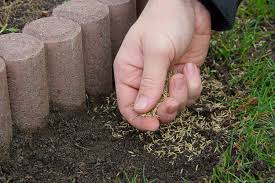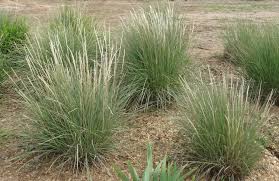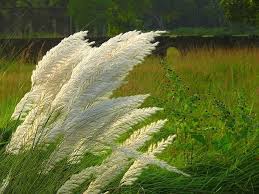Everything You Need To Know About Grass Seeding
Grass seeding is a fundamental and cost-effective way to establish a beautiful and healthy lawn. Whether you’re starting a new lawn from scratch or looking to revitalize an existing one, proper grass seeding is the key to achieving that lush, green carpet that enhances the beauty of your outdoor space.
To begin with, choose the right type of grass seed for your specific climate and soil conditions. Different grass varieties thrive in different environments, so take the time to research and select the best match for your area. This step ensures that your lawn will have the best chance of success and resilience against pests and diseases.
Next, prepare the soil for seeding. Clear the area of any debris, rocks, or weeds that might hinder the growth of your new grass. Rake the soil to create a smooth and level surface, which allows for even seed distribution. Adding some compost or organic matter can improve soil structure and fertility, promoting healthy root development.
When it’s time to sow the seeds, follow the recommended seeding rate provided on the seed packaging. Spreading the seeds evenly ensures uniform growth and prevents overcrowding, which can lead to weak and sparse patches in your lawn. Using a seed spreader or broadcasting by hand can help achieve an even distribution.
After sowing, gently rake the seeds into the soil to ensure good seed-to-soil contact, as this aids in germination. Lightly watering the seeded area with a fine spray is essential, as it helps settle the seeds into the soil and keeps the top layer moist for germination to take place. However, avoid excessive watering, as this could lead to waterlogging and seed rot.
Be patient during the germination process, as it may take several weeks for the grass to establish itself and become visible. Regularly monitor the moisture levels of the soil and make sure the newly seeded area doesn’t dry out. Once the grass has grown to a height of about 3 inches, you can gradually reduce the frequency of watering.
In the first few months after germination, avoid heavy foot traffic on the newly seeded area to allow the grass to establish strong roots. Mowing should also be delayed until the grass reaches a height of about 4 to 5 inches. When you do start mowing, set the blade to a higher setting to avoid cutting the grass too short, which could stress the young plants.
To maintain a healthy lawn, continue to water as needed, especially during dry periods, and fertilize according to the specific needs of the grass variety you have chosen. Regular mowing and occasional aeration will also contribute to a thriving and vibrant lawn.
In addition, grass seeding is a straightforward and rewarding process that allows you to create a lush and attractive lawn. By choosing the right grass type, preparing the soil properly, and following simple care guidelines, you can enjoy the beauty of a well-established lawn that adds value to your property and provides a pleasant outdoor space for relaxation and enjoyment. So, get your seeds ready and start the journey to a vibrant and green lawn today.
Read Also: Cutworms: How to Identify and Get Rid of Cutworms
Benefits of Grass Seeding

Grass seeding offers numerous benefits for both the environment and homeowners. Here are some of the key advantages of grass seeding:
1. Establishing a Lush and Vibrant Lawn: Grass seeding is a reliable method to create a lush, green lawn that enhances the beauty and aesthetics of your property. A well-maintained lawn can significantly increase the curb appeal of your home.
2. Cost-Effectiveness: Compared to other lawn establishment methods like sodding or hydroseeding, grass seeding is generally more affordable. It allows you to cover a larger area with a smaller budget.
3. Customization: Grass seeding offers a wide range of grass varieties to choose from. This allows homeowners to select the type of grass that best suits their specific climate, soil conditions, and aesthetic preferences.
4. Environmental Benefits: A healthy lawn contributes to the environment by absorbing carbon dioxide and releasing oxygen, helping to reduce greenhouse gas levels. Additionally, grass helps to filter and purify rainwater, preventing soil erosion and improving water quality.
5. Soil Improvement: Grass roots play a crucial role in soil health. They help to improve soil structure, promote microbial activity, and increase nutrient availability, making the soil more fertile and productive.
6. Erosion Control: Grass seeding on slopes and hillsides helps to prevent soil erosion by stabilizing the soil with a network of strong and dense roots.
7. Biodiversity Support: Lawns that consist of a diverse mix of grass species can provide habitat and food sources for various insects and small wildlife, contributing to local biodiversity.
8. Cooling Effect: Grass helps to cool the surrounding area by absorbing less heat than hard surfaces like concrete or asphalt. This cooling effect is especially beneficial in urban areas, where it can help mitigate the heat island effect.
9. Noise Reduction: Lawns act as natural noise barriers, absorbing and reducing noise levels from surrounding areas, providing a more peaceful and serene outdoor environment.
10. Recovery and Restoration: Grass seeding is an essential part of lawn recovery and restoration after events like drought, heavy foot traffic, or lawn diseases. It helps to rejuvenate the lawn and restore its health and appearance.
11. Low Maintenance Options: Certain grass varieties are low maintenance and require less water, mowing, and fertilization, making them an excellent choice for homeowners seeking an easy-to-care-for lawn.
However, grass seeding offers a multitude of benefits, ranging from environmental advantages to cost-effectiveness and improved property aesthetics. Whether you’re starting a new lawn or renovating an existing one, grass seeding can be a rewarding and sustainable way to create a healthy and vibrant outdoor space
A Complete Guide to Grass Seeding Process

Grass seeding is an essential process for establishing and maintaining a lush, green lawn. Whether you’re starting a new lawn from scratch or overseeding to improve an existing one, this comprehensive guide will walk you through the entire grass seeding process, step by step.
1. Choose the Right Grass Seed: Consider your climate, soil type, and sunlight conditions when selecting the grass seed. Different grass varieties thrive in various environments, so research and choose the best match for your region.
2. Prepare the Soil: Clear the area of debris, rocks, and weeds that could hinder grass growth.
Conduct a soil test to determine the pH and nutrient levels. Amend the soil if necessary with compost or fertilizer to create a fertile foundation for the new grass.
3. Time Your Seeding: The best time to seed depends on the type of grass and your location. In cool-season regions, early fall or spring is ideal, while warm-season areas are better suited for late spring to early summer.
4. Seed Distribution: For small areas, hand broadcasting can work well. For larger areas, consider using a seed spreader to achieve even seed distribution.
5. Seeding Rate: Follow the recommended seeding rate provided on the seed packaging. Over-seeding can lead to weak and sparse growth, while under-seeding may result in patchy areas.
6. Watering and Germination: After seeding, water the area with a fine spray to keep the soil consistently moist. Germination usually takes around 7 to 21 days, depending on the grass type and environmental conditions.
7. Early Lawn Care After Seeding: Avoid heavy foot traffic on the newly seeded area until the grass is well established.
Wait until the grass reaches a height of 3 to 4 inches before the first mowing. Set the mower to a higher setting to prevent stressing the young plants.
8. Regular Watering and Maintenance: Keep the lawn well-watered, especially during dry periods, to promote healthy growth.
Fertilize the lawn according to the specific needs of the grass variety you have chosen.
Mow regularly at the recommended height for the selected grass type to encourage dense and healthy growth.
9. Preventing Weeds: A dense and healthy lawn is the best defense against weeds. Proper watering, mowing, and fertilization can help prevent weed growth.
Consider using pre-emergent herbicides to inhibit weed seeds from germinating.
10. Aeration and Thatch Management: Periodic lawn aeration helps improve soil compaction and allows air, water, and nutrients to penetrate the roots.
Manage thatch buildup by dethatching when it exceeds half an inch to prevent it from suffocating the grass.
11. Overseeding and Renovation: Overseed your lawn regularly to fill in thin or bare areas and maintain a healthy, even lawn.
Renovate your lawn if it suffers from extensive damage, such as from pests, diseases, or drought. This involves more extensive soil preparation and seeding.
12. Winterization: Prepare your lawn for winter by providing it with adequate nutrients and cutting it slightly shorter before the first frost.
By following this complete guide to grass seeding and maintaining a healthy lawn, you can enjoy the beauty of a vibrant, green carpet that enhances the value of your property and provides a pleasant outdoor space for years to come. Remember to tailor your approach to your specific grass type and local climate for the best results.
Read Also: Categorization, Damages Caused, Diagnosis and Control Methods of Plant Diseases
Types of Grass Seeding
There are different methods or types of grass seeding that can be used to establish or renovate a lawn. Here are the main types of grass seeding:
1. Broadcast Seeding: This is a common method where grass seeds are scattered by hand or by using a seed spreader over the entire area to be seeded.
It is suitable for large areas and provides even distribution of seeds.
2. Drill Seeding: Also known as row seeding, this method involves using a seed drill or seeder machine to plant the seeds in rows or furrows.
It is often used for planting grass in rows for pasture, erosion control, or reseeding damaged areas.
3. Hydroseeding: In hydroseeding, a mixture of grass seeds, water, mulch, and other additives is sprayed onto the prepared soil surface using a specialized machine.
This method helps to retain moisture, promote germination, and prevent erosion.
4. Slit Seeding: This technique uses a slit seeder machine that creates narrow slits in the soil and drops the seeds directly into the slits.
It provides good seed-to-soil contact, enhancing germination rates and seedling establishment.
5. Dormant Seeding: Dormant seeding is performed during the winter months when the ground is frozen but not covered with snow.
The freeze-thaw cycles help the seeds work their way into the soil, ready to germinate once spring arrives.
6. Overseeding: Overseeding involves spreading grass seeds over an existing lawn to fill in bare spots, improve density, or introduce new grass varieties.
It helps rejuvenate an older lawn and maintain a lush and healthy appearance.
7. Combining Techniques: In some cases, a combination of seeding techniques may be used to achieve the desired results.
For example, overseeding can be combined with hydroseeding to enhance a lawn’s appearance and resilience.
Each grass seeding method has its advantages and is suited for specific situations. The choice of seeding technique depends on factors such as the lawn’s condition, the size of the area to be seeded, environmental factors, and the specific goals of the grass seeding project.
Read Also: What You Should Know About Koosh Balls









